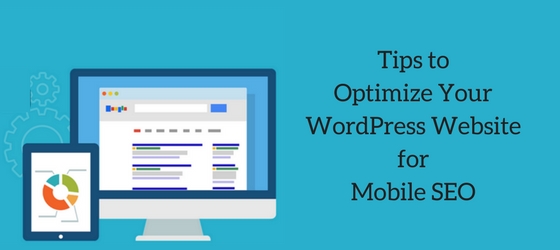Most people have optimized their website in one way or another, but have you ever done anything particularly for your mobile visitors?
In 2018, more traffic originated from mobile than desktop, and that number is only going to increase. People are utilizing their devices more and more, and they require that you make it easy for them to access your website.
Multiple sites are not optimized for mobile beyond a simple responsive theme. Transferring your site layout around for small screens is not enough to fascinate and convert your mobile visitors. You have to make sure your mobile website is fast, easy to use, and intended specifically for small screens.
What is Mobile SEO?
Mobile SEO is the method of optimizing your website for users on smartphones & tablets. Mobile optimization also involves making your website resources accessible to search engine spiders.
Why is Mobile SEO Important?
Mobile optimization ensures that mobile visitors have an experience optimized for their mobile device and takes into consideration website design, site structure, page speed and more to provide a quality mobile user experience.
In fact, 58% of all searches in Google are made from a mobile device, and this trend is growing rapidly. According to Google reports, there are more than 27.8 billion queries made on mobile than the desktop. Therefore, Mobile is the future of SEO, and that’s apparently why Google is modernizing their entire algorithm to focus on mobile search.
How to Make a Website Mobile-Friendly
Let’s look at the great ways you can optimize your WordPress website today.
1. Speed Up Your Mobile Site
The most significant thing you can do is speed up your website. People suspect websites to load quickly on mobile, mainly when they are on the go. The faster load times can boost conversions and reduce bounce rates, while the slow load times will send them to your rivals.
Here are three essential things you can do right now to speed up your website for mobile.
Reduce Images
Big images can slow down your page load times largely. The good thing is that it’s a much easy to fix.
The primary thing to do is look at your website pages, and get rid of any images that are not necessary. If your images are to make your website look pretty, they are not converting your visitors. Try a/b testing with and without some of your main images, and you may discover that it makes no difference.
If the images need to stay, make sure to optimize any big images on your main landing pages. You can utilize a tool like Imagify, which also has a WordPress plugin. This tool will shrink your images without losing quality, so your web pages load faster but still look great.
Besides, the responsive images are assisting with load times, and lucky for you they are already in WordPress.
Optimize Plugins and Themes
Inadequate plugin and theme code can sometimes make a problem for your website speed, even if you optimize everything else.
If you are noticing a significant slowdown, try to update all plugins, themes, and WordPress core. If that does not fix the issue, deactivate plugins on a staging site till you identify the culprit. You may also require switching themes to one of the default WordPress themes, such as TwentySeventeen. When you have located the problem, you can either leave it inactive or attempt to clear the issue.
Another vital thing you can do is minify and focus plugin CSS and JS files. A plugin like WP Rocket can assist with that; make sure you contact your web host if you utilize a caching plugin. Some caching might be irrelevant in a hosting environment like Pagely’s that is before heavily optimized.
Use a Great Web Host
You are reading this on Pagely, so the chances are that you previously have a great host.
If you are on a low shared hosting server somewhere else, merely enhancing your hosting account can do a lot. Run WordPress hosts like Pagely have server support and caching in place that will speed up your website exceedingly. They also support modern technologies such as PHP 7, which is four times faster than PHP 5.4. It also involves a CDN which can speed up your website images and other assets, and it’s effortless to use.
2. Don’t Stop at Responsive
The responsive design is significant, but it’s not enough to merely buy a responsive theme.
The problem is that only a responsive theme is not enough. All it does is drive your content around for small screens, but it does not account for the fact that mobile users want to see different things than desktop users.
For example, if you have a restaurant website, mobile users just want to see your menu, hours, and how to reach your location. The desktop users might have the ability to scroll through more images of your website, read your blog posts, and enlist to your newsletter, but you don’t need to go down your mobile users with too much of that. If you have a responsive theme, you are ready to show mobile users what they want quickly.
Designing an experience deliberately for your mobile visitors may need detecting devices on the server level, and creating a different experience for them in your theme. You can utilize the built-in wp_is_mobile() function to make that in your theme templates, which will go a much further than replacing columns with CSS.
3. Consider a Mobile App
I already mentioned that mobile internet usage had surpassed the desktop. The thing I did not state is that most of the internet time on a device is spent on mobile apps.
Mobile Apps account for 89% of mobile media time, with the other 11% spent on websites. – Smart Insights
In mobile SEO, designing a holistic mobile experience for your audience, and for many businesses that include a native mobile app. Apps concede for a faster, more focused experience, as well as features that are not possible on the web.
You can also spread through the iOS and Android app stores, which provides you another point of contact to engage with your consumers.
Many businesses can avail from mobile apps to companion their website. There is a lot of ways to build an app including custom development or a DIY app builder. The custom app development is an excellent way to get an app created if you have the budget for it. App developers are a dime a dozen, but they don’t all blend with WordPress on the same level. A tool like AppPresser concentrates specifically on WordPress based websites and can assist you to create an app with minimum cost.
4. Avoid Common SEO Mistakes
Google gives some help to website owners who are struggling with improving their mobile SEO.
The primary thing to do is fetch your website as Google to see if there are any issues you want to be aware of. You can do this within the Google Search Console.
After you fetch your website as Google, it will reveal you any problems with your site that you must to fix.
Moreover, you should make sure you are not using a misconfigured robots.txt file or sitemap, which can tackle Google from accessing your website. Check for bad redirects or broken links, particularly any that would only affect mobile. Utilizing a plugin like Yoast SEO will also assist you to improve your SEO, and identify some errors.
If you are utilizing a popup plugin or app download interstitial, make sure it does not block the whole screen on mobile. Preferably, use a less intrusive banner, or deactivate popups for mobile.
Additionally, your font size should be legible on mobile. I prefer a sizeable mobile font of 16px. Your long-form articles should be one-column with no sidebars on a small screen. Furthermore, make sure any buttons are at least 44px high, which is the wanted size according to Apple.
5. Track Your Progress
If you are doing all the work of optimizing for mobile and make sure you track how well you are doing.
Google Analytics can track mobile visits independently from the desktop, using a feature called segmenting. Utilizing this feature, you can find how much of your traffic is mobile, where it’s coming from, and which pages are being seen.
To allow a mobile segment, log into your Google Analytics account and go to Audience section. Then click “Overview” (if it’s not there already) then click “Add Segment” at the top of the web page. This will explain you all of your possible segments, and you can choose “Mobile Traffic.”
You can also uncheck “All Traffic” to see mobile only or leave it checked for comparison. Click the “Apply” button below the segments, and now you will notice your new segmented data.
Now, you should be ready to see the percentage of mobile-only traffic to your website, and you may click on other navigation items to view additional data. For instance, if I go to Behavior => Site Content => All Pages, I can notice that my pricing page is the #1 visited page on mobile.
With the mobile segment enabled, you can now compare different dates, and hopefully, see improved engagement on mobile as you apply these mobile SEO tips.
Conclusion
Nowadays, mobile SEO is really essential. As mobile usage continues to evolve, it’s critical that you enhance the mobile experience on your website.
If you do nothing else, concentrate on speeding up your web page load time for mobile users. A responsive theme will assist increase your website’s readability on small screens, but you should also think to design a mobile-only experience.
A mobile app may be a great approach to engage with your audience in a new way. It is allowing them offline access to your content and more focused experience. Eventually, make sure you track your progress with Google Analytics or another platform because what gets measured becomes done.



Great post! Thank the post about wordpress seo